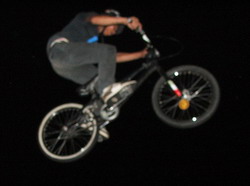Extreme Sports taking off in Cuba
- Submitted by: admin
- Sports
- 09 / 17 / 2007

Great rejoicing, applauses, whistles and screams led the driver the exact place of the competition: Havanas Metro Park. Despite the unrelenting summer sun, and the less than top-quality grandstands, hundreds of young people surround a trail on which a variety of obstacles are scattered.
Though the contest should have begun earlier, participants eagerly awaited several pieces of audio equipment - that never arrived. Nonetheless, they decided to start. At 12:20 p.m., young Miguel Domínguez Mesa, one of the organizers, began to read the lists of competitors and rules for each discipline.
"Skaters will compete first; then will come skateboarders, and bikers will compete at the end. Those who classify today will move on to the final round, which will be held tomorrow, when we will select the winner of each speciality," shouts Domínguez. Then, he calls the first competitor.
For more than four hours, dozens of young people show off their most well-honed skills and techniques in the practice of extreme sports. They perform unimaginable acrobatics with their inline skates, skating boards and bicycles.
Using their skates and skateboards, they went from one side to the other in a tube, went up and down of a little ramp and performed pirouettes in the air, showing the wheels of their skates and bicycles to the public.
This last discipline was the most liked by the spectators. There were "suicidal" competitors such as Dani Daniel Hernández, who on three different occasions tried to perform a death threatening spin on his bike, and ended up on the ground three times.
Other young athletes made the public gaze with open mouths and with their hands on their head due to the complexity of their tricks. The contestants proved that to practice this sport one needs a high dose of courage and creativity - but especially lots of adrenaline.
We could see that the practice of extreme sports is trying once again to gain a place among fans, of whom there are many and are grateful for the exhibitions.
Extreme sports are not something new in Cuba
The first examples of extreme sports appeared in the United States in the 20th century. At least, thats the case of extremes sports with bicycles, skates, skateboards and boards.
In 1963, an American, Al Fritz, the director of a bicycle factory, was told that there was not a single bike left in stores in Los Angeles. Young people had bought them all out. They modernized them with long banana seats and cruised the streets trying to perform the same pirouettes as their motocross idols. They made the most of open ground, construction areas, or whatever place was available to perform abrupt jumps and manoeuvres.
The boom of this type of bicycle induced the Fritz factory modernize its production, which resulted in increased profits. The fad crossed the ocean going from the United States to Europe and then to Latin America in the 1980s.
In Cuba, the first practices of those sports began in the end of the 1980s, according to publications of that time. In 1988 some young people in the capital began to practice extreme sports with skateboards, rollerblades and BMX bikes.
"Skateboarding is a recreational sport barely known in Cuba, but already has a number of followers among young people," published the Cuban magazine Somos Jovenes in 1988. From that time up to five years ago, the practices were not largely developed until the national management of Cubas National Institute of Sports and Recreation (INDER by its abbreviation in Spanish) began to organize and assist the practice of these disciplines, although support is still lacking.
What is missing...
Young Che Alejandro has been skateboarding for almost 25 years. He began when he was 10. Now, due to all his injuries and the condition of his knees, he cannot do it as often as he used to. Therefore, he ahs become one of the most passionate promoters of this sport in Cuba.
"There are difficulties that prevent us for developing these sports. The support of the INDER is still insufficient and buying the means to practice it is very difficult," he says.
The limited availability of places to practice is another problem faced by the young people interested in extreme sports.
Will vs. the Way
"The practice of these sports is very expensive worldwide. The equipment and the places to practice are very expensive. Cuba has been trying in the last few years to develop this activity, but we have to prioritize the development of sports and activities on which we are already a power," explains Fidel Bonilla, head of the National Direction of Recreation in INDER.
"Weve achieved some advances, but we acknowledge that the economic support given to these activities is not enough. This situation will change when we have more financial possibilities. Right now, what we have on our side is tons of will and disposition to assist those young people with everything we can," Bonilla says.
But there have been some moves towards the practice of these sports. A number of national competitions have been organized and there are more than 3,000 people practicing it systematically.
"We are getting some equipment through donations, but the idea is that they can be manufactured but the Cuban sport industry in the future. A plan has also been approved to build an open area in the capital following the international standards," Bonilla said.
What cannot be denied, however, is the great reception of these sports by thousands of amateurs and sportspeople in Cuba, as well as the institutional disposition to develop them - despite economic difficulties. With both ingredients, we should not be amazed if in the next five years Cuba will see international champions in extreme sports.
Source: By Norge Martínez Moreno, Juventud Rebelde
Comments